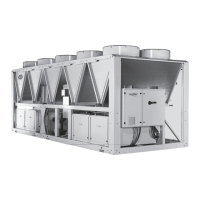18
Connecting Ductwork
Refer to the Carrier System Design Manual for the recommended
design and layout of ductwork.
DISCHARGE CONNECTION
Duct flanges are factory-supplied; they are shipped inside the unit
attached to the hairpin end of the coil tube sheet for field installa-
tion. Using the existing screws, install the duct flange on the unit’s
fan deck. The fan discharge requires 2 flanges; each flange must
be bent in the middle to conform to the discharge opening. (See
Fig. 18.) After flanges are installed, connect them to the supply
duct using a canvas connection to prevent vibration. It is important
that this connection be properly fabricated to prevent high air fric-
tion losses and air noise.
RETURN CONNECTIONS
When using return-air ductwork, route return-air duct to the unit’s
return air inlet near the filter rack, using a canvas connection to
prevent transmission of unit vibration. If the duct blocks off the
unit’s access panel, provide a slip joint in the ductwork to permit
removal for servicing.
OUTDOOR-AIR INLET CONNECTIONS
Connect outdoor-air inlet to field-installed accessory economizer.
Refer to Economizer Installation Instructions.
Return-Air Filters
Type and size of filters are shown in Tables 1-3 and are factory-
supplied and factory-installed. In all units with 2 fans, a filter
replacement tool (hook) is shipped inside the unit for field use
when replacing filters. See the Service section for instructions on
filter element replacement.
Fig. 18 — Duct Flange Installation
CAUTION
UNIT OPERATION HAZARD
Failure to follow this caution could cause equipment damage.
Do not operate unit without ductwork or discharge plenum
unless fan speed has been adjusted for external static pressure
of zero in. wg. Failure to do so may result in motor overload.

